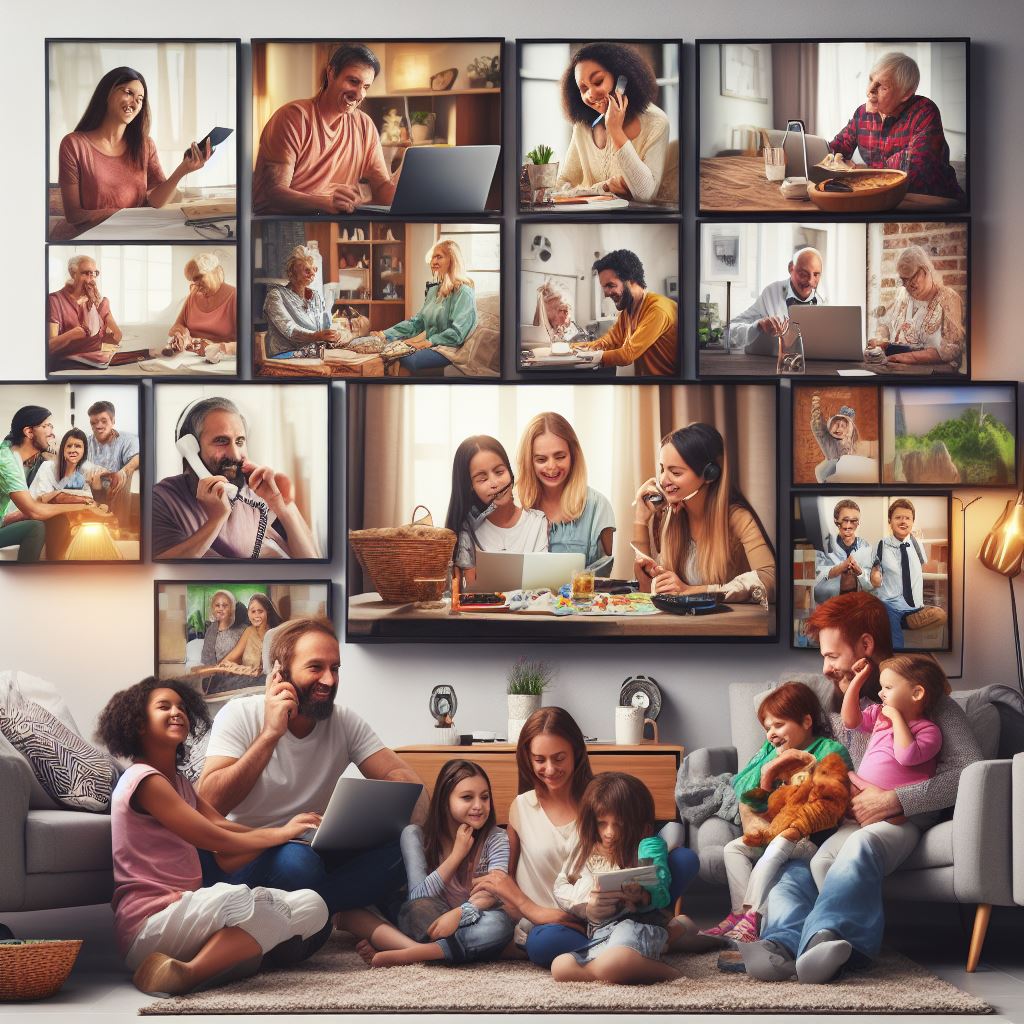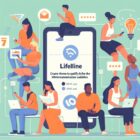8 Best Telecom Subsidies for Low-Income Households

Looking for the best telecom subsidies to help low-income households? You’re in luck! We’ve compiled a list of the top 8 programs that can provide you with affordable communication options.
From the Federal Lifeline Program to state-specific subsidies, these initiatives aim to bridge the digital divide and ensure everyone has access to essential services.
So, let’s dive in and discover the telecommunications support available for you.
Key Takeaways
- The Federal Lifeline Program and the Emergency Broadband Benefit Program are federal subsidy programs that aim to provide affordable communication services to low-income households.
- The ConnectHome Initiative, launched by the U.S. Department of Housing and Urban Development, offers support in bridging the digital divide for low-income households, providing broadband access, digital literacy training, and affordable devices.
- Each state in the US has its own state-specific telecom subsidy programs, such as the California Lifeline Program, Lifeline Assistance Program in New York, Telephone Lifeline Service Discount Program in Texas, and Lifeline Program for the Hearing or Speech-Impaired in Illinois, which provide discounted phone and internet services to eligible low-income households.
- Community Connect Grants and Tribal Subsidy Programs, such as the Tribal Link-Up Program and Lifeline-supported Mobile Broadband, also play a significant role in providing affordable communication services to low-income households, particularly in rural and tribal areas.
Federal Lifeline Program
If you’re a low-income household, you can benefit from the Federal Lifeline Program, which provides subsidies for telecom services. This program, established by the Federal Communications Commission (FCC), aims to ensure that all Americans have access to affordable communication services.
Through the Lifeline Program, eligible households can receive a monthly discount on their phone or internet bills. The amount of the subsidy varies depending on your location and the service provider you choose. To qualify for the Lifeline Program, you must meet certain income criteria or participate in certain federal assistance programs such as Medicaid, SNAP, or Federal Public Housing Assistance. Applying for the program is simple and can be done through your chosen service provider.
By participating in the Lifeline Program, you can save money on your telecom expenses, allowing you to stay connected with loved ones, search for employment opportunities, and access important online resources.
Transitioning to the next section, another initiative that aims to bridge the digital divide is the ConnectHome initiative.
ConnectHome Initiative
The ConnectHome Initiative offers further support in bridging the digital divide for low-income households by providing access to affordable internet services. This initiative, launched by the U.S. Department of Housing and Urban Development (HUD) in 2015, aims to connect more families to the internet and provide them with the necessary tools to thrive in the digital age.
Key features of the ConnectHome Initiative include:
- Broadband access: The initiative partners with internet service providers to offer low-cost internet plans specifically tailored for low-income households. This enables families to access online resources, job opportunities, educational materials, and healthcare information that are essential for their overall well-being.
- Digital literacy training: ConnectHome also focuses on providing digital literacy training for residents in low-income communities. Through partnerships with local organizations, residents receive training on how to effectively use the internet, navigate online platforms, and stay safe online. This equips them with the necessary skills to fully utilize the benefits of the internet.
- Affordable devices: In addition to low-cost internet plans, ConnectHome also helps families access affordable devices such as computers and tablets. This ensures that households have the necessary hardware to make the most out of their internet connection.
- Community support: The ConnectHome Initiative fosters collaboration between public and private entities, nonprofit organizations, and local communities. This collective effort helps to provide ongoing support and resources to low-income households, ensuring that they’ve the tools and knowledge needed to succeed in the digital world.
Emergency Broadband Benefit Program
The Emergency Broadband Benefit Program offers a lifeline for low-income households by providing subsidies for broadband access. To qualify for the program, individuals must meet specific eligibility criteria, such as participating in certain federal assistance programs or experiencing a substantial loss of income during the pandemic.
The benefits of broadband access are significant, as it enables individuals to access vital services, educational resources, and employment opportunities. This program has the potential to make a profound impact on low-income households, bridging the digital divide and increasing their overall well-being.
Eligibility Criteria for Program
To qualify for the Emergency Broadband Benefit Program, you must meet certain eligibility criteria. Here are the four key requirements:
- Income: Your household income must be at or below 135% of the Federal Poverty Guidelines or participate in certain assistance programs like SNAP, Medicaid, or Lifeline.
- Job Loss or Furlough: If you experienced a substantial loss of income due to job loss or furlough since February 29, 2020, you may be eligible for the program.
- Eligibility for Existing Assistance Programs: If you already participate in certain assistance programs like Lifeline, Medicaid, or SNAP, you automatically qualify for the Emergency Broadband Benefit Program.
- Connected to Tribal Lands: If you live on tribal lands and receive benefits from programs like Tribal Temporary Assistance for Needy Families (Tribal TANF), you’re eligible for the program.
Meeting these eligibility criteria ensures that the program reaches those who need it most.
Benefits of Broadband Access
With access to broadband, you can connect to essential services and opportunities that can improve your life.
The Emergency Broadband Benefit Program offers several benefits to low-income households. Firstly, it provides affordable broadband service, allowing you to stay connected with family, friends, and colleagues. This is especially important in today’s digital age, where many important activities such as education, job searching, and healthcare consultations are conducted online.
Additionally, broadband access enables you to access vital information and resources, such as government assistance programs, online banking, and job training platforms. It also opens up opportunities for remote work or online entrepreneurship, providing a pathway to increased income and financial stability.
Furthermore, broadband access can improve access to telehealth services, allowing you to consult with healthcare professionals remotely, saving time and money.
Impact on Low-Income Households
Stay connected and reap the benefits of the Emergency Broadband Benefit Program, which has a significant impact on low-income households. Here are four ways this program is making a difference:
- Affordable internet access: The program provides a monthly discount of up to $50 for broadband services, making it more affordable for low-income households to stay connected.
- Device assistance: The program also offers a one-time discount of up to $100 for purchasing a laptop, tablet, or desktop computer. This helps bridge the digital divide and ensures that low-income households have the necessary devices to access the internet.
- Enhanced telecommunication services: In addition to internet access, the program covers voice services, allowing low-income households to make phone calls and stay connected with their loved ones.
- Educational benefits: The Emergency Broadband Benefit Program supports online learning by providing access to educational resources and tools. This helps low-income students keep up with their studies and access the same educational opportunities as their peers.
Lifeline Broadband Pilot Program
You can access the Lifeline Broadband Pilot Program, a government initiative aimed at providing affordable internet access to low-income households. This program is part of the Federal Communications Commission’s (FCC) Lifeline program, which has been in place since 1985 and helps eligible low-income households afford basic telephone service. The Lifeline Broadband Pilot Program expands on this by offering discounted broadband internet service to qualifying households.
The Lifeline Broadband Pilot Program offers eligible households a monthly subsidy of up to $50 to help cover the cost of broadband internet service. To qualify for the program, individuals must have an income at or below 135% of the Federal Poverty Guidelines or participate in certain assistance programs such as Medicaid, Supplemental Nutrition Assistance Program (SNAP), or Federal Public Housing Assistance (FPHA).
To give you a better understanding of the program’s eligibility requirements, here is a table summarizing the qualifications:
| Eligibility Criteria | Income Requirements | Assistance Programs |
|---|---|---|
| Income | At or below 135% of the Federal Poverty Guidelines | – |
| Participation in Assistance Programs | – | Medicaid, SNAP, FPHA |
Community Connect Grants
Community Connect Grants provide an opportunity for low-income households to access reliable telecommunications services. To be eligible for these grants, households must meet certain criteria, such as being located in a rural area with limited broadband access.
The application process for Community Connect Grants is explained in detail, ensuring transparency and accessibility for those in need.
These grants have a significant impact on low-income households by bridging the digital divide and allowing them to stay connected in today’s increasingly digital world.
Eligibility Criteria for Grants
To qualify for Community Connect Grants, you must meet specific eligibility criteria. These criteria ensure that the grants are awarded to the most deserving individuals and organizations. Here are the key requirements you need to fulfill:
- Geographical Location: You must be located in a rural area that lacks access to reliable broadband service.
- Income Level: Your household income should fall within the low-income bracket defined by the U.S. Department of Agriculture’s Rural Development program.
- Legal Entity Status: To apply for the grant as an organization, you must be a legally recognized entity, such as a local government, Indian tribe, or non-profit organization.
- Technical Expertise: You should have the technical knowledge and capacity to implement the proposed broadband infrastructure project.
Meeting these criteria is essential to be considered for a Community Connect Grant. Once you have determined your eligibility, you can proceed to the application process explained in the next section.
Application Process Explained
Once you have met the eligibility criteria for Community Connect Grants, you can proceed to the next step of the application process.
The first step is to complete the necessary paperwork, which includes filling out the application form and providing all required documentation. You’ll need to provide information such as your organization’s name, address, contact information, and a description of the project for which you’re seeking funding. Additionally, you may be required to submit a budget proposal and a project timeline.
Once your application is complete, you can submit it to the appropriate agency or organization responsible for reviewing and awarding the grants. It’s important to carefully follow all instructions and deadlines to ensure that your application is considered.
Upon successful approval, the impact of these grants on low-income households can be significant, providing access to vital telecommunications services that they may otherwise not have been able to afford.
Impact on Low-Income Households
When applying for the Community Connect Grants, you can expect a significant impact on low-income households. These grants aim to provide access to broadband services in rural areas, improving connectivity and communication for those who may not have had these resources before.
Here are four ways in which the Community Connect Grants can positively affect low-income households:
- Increased access to educational resources: With broadband access, low-income households can now access online learning platforms, educational videos, and resources that were previously out of reach.
- Improved job opportunities: Having reliable internet access opens up opportunities for remote work, online job applications, and access to online training programs, allowing low-income individuals to expand their employment opportunities.
- Enhanced access to healthcare services: Telemedicine and online consultations become accessible, allowing low-income households to receive medical advice and treatment without the need for expensive travel or appointments.
- Strengthened community engagement: Broadband access enables low-income households to connect with their communities through online forums, social media, and local government websites, fostering a sense of belonging and participation.
Tribal Link-Up Program
You can benefit from the Tribal Link-Up Program if you’re a low-income household seeking telecom subsidies. The Tribal Link-Up Program is a government initiative that aims to provide affordable telecommunications services to Native American households living on tribal lands.
The program offers eligible households a one-time discount of up to $100 to help cover the costs of initiating telephone service. This discount can be used towards the installation or activation fees associated with setting up a landline or mobile phone service. Additionally, the program also provides a monthly subsidy of up to $34.25 to help reduce the ongoing cost of telecommunications services.
To qualify for the Tribal Link-Up Program, you must be a member of a federally recognized tribe living on tribal lands and meet specific income requirements. These requirements vary depending on the number of people in your household and the state you reside in.
The Tribal Link-Up Program is a valuable resource for low-income Native American households, ensuring that they’ve access to essential communication services at an affordable cost.
Lifeline-supported Mobile Broadband
Continue the discussion from the previous subtopic, the Tribal Link-Up Program, by exploring the benefits of Lifeline-supported Mobile Broadband for low-income households.
Lifeline-supported Mobile Broadband is a program that aims to provide affordable internet access to low-income individuals and families. Here are four key benefits of Lifeline-supported Mobile Broadband:
- Access to Information: Mobile broadband allows low-income households to access the internet, providing them with a wealth of information and resources. This can help them stay connected with family and friends, search for job opportunities, access educational materials, and stay informed about important news and events.
- Educational Opportunities: With mobile broadband, low-income households can access online educational resources, including e-learning platforms, digital libraries, and online courses. This enables them to enhance their skills, gain knowledge, and improve their chances of finding better employment opportunities.
- Job Search and Employment: Mobile broadband enables low-income individuals to search for jobs online, submit applications, and connect with potential employers. This can be especially beneficial for those who may not have access to transportation or live in remote areas with limited job opportunities.
- Social and Civic Engagement: Mobile broadband allows low-income households to participate in social and civic activities. They can connect with others through social media platforms, access government services and resources, and engage in online communities, increasing their social connections and civic participation.
With the benefits of Lifeline-supported Mobile Broadband, low-income households can overcome barriers to internet access and fully participate in today’s digital society.
Now let’s move on to the next section and explore state-specific telecom subsidies.
State-specific Telecom Subsidies
To find the best telecom subsidies for low-income households, start by exploring the various state-specific options available to you. Each state in the US has its own programs and initiatives designed to provide affordable telecommunications services to those in need. These state-specific subsidies can help eligible households gain access to essential communication services, such as phone and internet, at reduced rates or even for free.
Here is a table showcasing a few examples of state-specific telecom subsidies:
| State | Telecom Subsidy Program |
|---|---|
| California | California Lifeline Program |
| New York | Lifeline Assistance Program |
| Texas | Telephone Lifeline Service Discount Program |
| Florida | Lifeline Assistance Program |
| Illinois | Lifeline Program for the Hearing or Speech-Impaired |
These programs vary in eligibility criteria, benefits, and application processes, so it’s important to research and understand the specific requirements in your state. Some states may have additional subsidies or discounts for specific groups, such as veterans, seniors, or individuals with disabilities. By exploring these state-specific options, you can find a telecom subsidy program that best suits your needs and helps you stay connected without straining your budget.
Frequently Asked Questions
How Can I Apply for the Federal Lifeline Program?
You can apply for the federal lifeline program by contacting a participating telecom provider. They will guide you through the application process and help determine if you meet the eligibility criteria.
What Is the Eligibility Criteria for the Emergency Broadband Benefit Program?
To qualify for the Emergency Broadband Benefit Program, you must meet certain eligibility criteria. These include having a household income at or below 135% of the federal poverty guidelines or participating in certain assistance programs.
Are There Any Restrictions on the Usage of Lifeline-Supported Mobile Broadband?
There are restrictions on the usage of lifeline-supported mobile broadband. These restrictions can vary depending on the specific program or provider. It is important to review the terms and conditions to understand the limitations.
How Can Low-Income Households Benefit From the Connecthome Initiative?
You can benefit from the ConnectHome initiative if you’re from a low-income household. It provides telecom subsidies that can help you access affordable broadband services, bridging the digital divide and promoting connectivity for all.
Are There Any Additional Benefits or Discounts Available Under the State-Specific Telecom Subsidies?
Are there more discounts or benefits available with state-specific telecom subsidies? Yes, there are additional benefits like reduced monthly bills and free installation. These subsidies help low-income households stay connected without breaking the bank.



